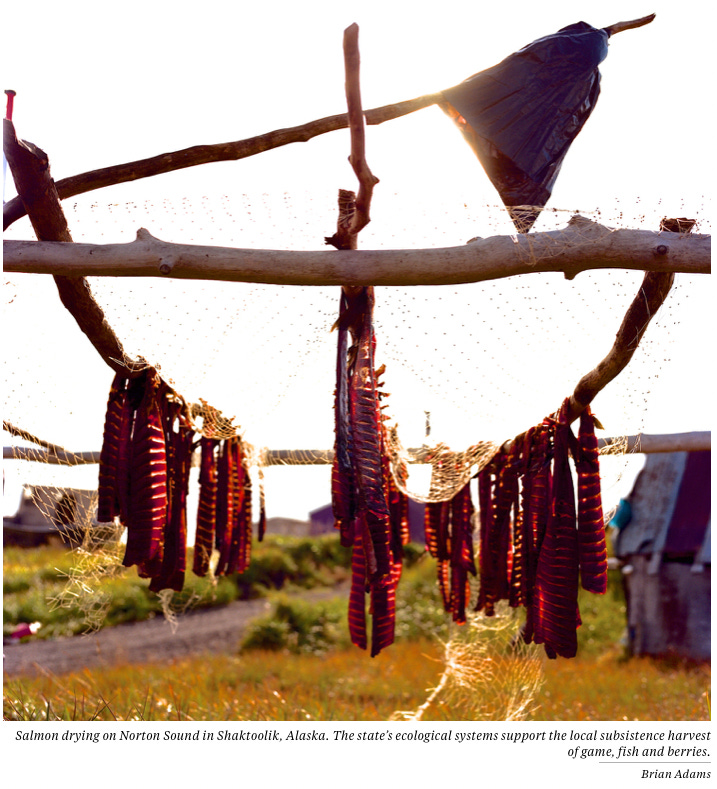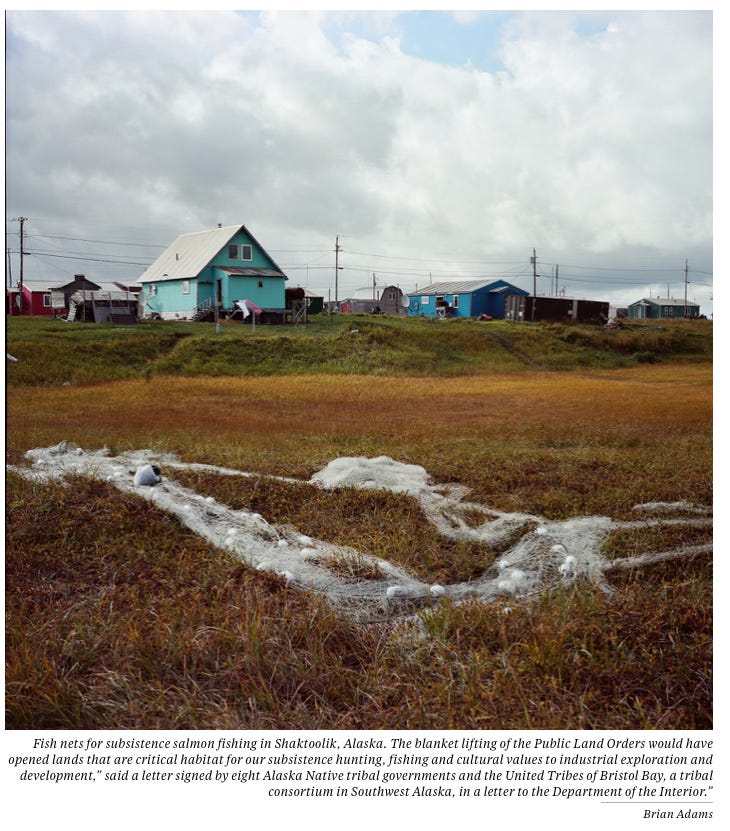Trump tried to open Alaska lands to resource development — what will Biden do?
By Avery Lill (First published in the High Country News and used with permission)
It’s easy to stake a mining claim on public land in much of the United States, though a significant portion of Alaska is off-limits, at least for now. However, the Bureau of Land Management is considering whether to open about 28 million acres across the state to mineral development.
Those acres have been closed to mining since the 1970s, thanks to the Alaska Native Claims Settlement Act. As a result of the act, the Department of the Interior, which oversees the BLM, disallowed mining claims and mineral leases on most BLM-managed land in Alaska. The move was initiated in section 17(d)(1) of the law, so the lands are often called “d-1 withdrawals.” But this de facto protection was never intended to be permanent; rather, it was designed to give the Interior Department time to study the parcels and decide how to handle their long-term management and protection.
In northwest Alaska, Doug Katchatag knows the land by its wildlife and its rivers, not its BLM classification. Katchatag, president of the Norton Bay Inter-Tribal Watershed Council, has fished and hunted along the Shaktoolik and North rivers near Unalakleet, Alaska, since he was a boy in the 1960s. In decades past, his sled dogs would catch the scent of game before he could see it. “My dogs start sniffing the air,” he said. “It’s either a moose or caribou.”
Katchatag (Inupiaq, Native Village of Unalakleet) said he remembers his dogs leading him to herds of caribou milling on the tundra, where he could choose which animals to harvest. His elders taught him to look for the old and fat individuals. But caribou are scarce in the area now, likely due in part to climate change. And Katchatag worries that if the BLM opens more land in Alaska to mineral development, it could further damage the fragile ecological systems that support the local subsistence harvest of game, fish and berries.
“To open up mining would kill everything,” he said. “It would look like a ghost town, ghost river.”
The 28 million acres the BLM is considering opening were nearly made available for mineral development
almost two years ago. In the final days of the Trump administration, then-Interior Secretary David Bernhardt signed orders that would have revoked d-1 withdrawals and allowed mineral leasing and mining claims across swaths of Alaska, making it the largest opening of public land to mining in contemporary U.S. history, according to Pew Charitable Trusts. Bernhardt’s move was based on BLM guidance issued in the early 2000s, during George W. Bush’s presidency, which recommended lifting many d-1 withdrawals because they had “outlived their original purpose.” One of the Interior Department’s earliest acts under President Joe Biden was to pause Bernhardt’s orders for up to two years, citing what it described as procedural and legal defects.
Mining groups, including the National Mining Association, opposed the move. Alaska Sen. Lisa Murkowski, R, said pausing Bernhardt’s orders was “egregious,” at a Senate Committee on Energy and Natural Resources hearing shortly after the decision was announced. “People in Alaska are anxious,” she said. “They’re upset. They’re mad.” The state of Alaska challenged the Department of Interior’s decision. The case was dismissed in federal court, but an appeal is ongoing.
At the same time, tribal organizations and environmental advocacy groups celebrated the Biden administration’s decision. “The blanket lifting of the Public Land Orders would have opened lands that are critical habitat for our subsistence hunting, fishing and cultural values to industrial exploration and development,” said a letter signed by eight Alaska Native tribal governments and the United Tribes of Bristol Bay, a tribal consortium in Southwest Alaska, in a letter to the Department of the Interior. “The Bureau’s decision …is being celebrated across our state as a win for the hundreds of communities that rely upon BLM lands for physical and cultural sustenance.”
NOW THE BIDEN ADMINISTRATION is coming up on its 2023 deadline for deciding what to do with Bernhardt’s public land orders. The BLM is taking public comment until mid-October on how it should assess the potential environmental impacts of allowing mining on these lands. The agency said it will also consult affected tribal nations and Alaska Native corporations.
The BLM could leave current d-1 withdrawals in place. That’s what Rachel James, head of advocacy group SalmonState’s public lands and waters program, hopes will happen. She’s encouraged that the agency is taking the time to listen to the public. When the Trump administration opened different d-1 withdrawals in 2018 and 2019 in the Fortymile Area and around Goodnews Bay and Bering Glacier, rather than soliciting public comments, it simply announced the decisions in the Federal Register.
“The fact that the Biden administration has prioritized asking local people … what they think should happen to these lands is not only historic, but it's just the right thing,” said James. “The agency will see without a shred of a doubt that these lands should stay as they are, that this is really, literally, the bread basket for so many communities, that these lands are critical to so many different species of fish, of wildlife, across the state.”
Katchatag, however, sees a long, uphill road ahead. He’s been resisting mining in Norton Sound for decades, and after so many years, he’s frustrated. “We could oppose (mining) all we want … but in the long run, it don’t mean nothing,” he said. Still, he’s determined to keep fighting to protect the land for future generations. He says he’ll attend the BLM’s upcoming public meetings about Bernhardt’s orders to reiterate what he has been telling federal officials for years.
“Ninety percent of our population here rely on the sea for food, for fish, and land for caribou and beaver and whatnot,” said Katchatag. “If they were to open up a mine … we’d have nothing.”
The deadline to submit a comment is Oct. 17.
See the original article at: https://www.hcn.org/articles/north-energy-industry-trump-tried-to-open-alaska-lands-to-resource-development-what-will-biden-do





